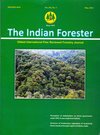Relationship of Edaphic Factors on the Pathogenicity of Root Rot of Bael Caused by Fusarium solani
DOI:
https://doi.org/10.36808/if/2016/v142i5/95062Keywords:
Edaphic Factor, Pathogenicity, Root Rot, Bael, Fusarium solani, Seedling.Abstract
An investigation to study the influence of edaphic factors on the pathogenicity of root rot of bael caused by Fusarium solani showed that the seedling mortality increased with the increase in inoculum levels of either of the media i.e. PDB and wheat grains. The maximum mortality (26.25% pre-emergence and 38.50% post-emergence) in case of mycelial mat was observed in soil inoculated with 4 kg soil whereas in case of wheat grain culture, maximum mortality (28.00% pre-emergence and 40.25% post-emergence) was observed in soil inoculated with 40g kg-1 soil. The disease incidence was observed more on young seedlings and there was significant decrease in disease incidence with the increase in seedling age. Mortality of seedlings were maximum (46.25%) when 5 days old seedlings transplanted in wheat grain inoculated soil, whereas 40 days old seedlings showed 22.50 per cent disease incidence. The maximum pre (40.25%) and post (38.50%) emergence seedling mortality was observed when soil was inoculated at 5 cm depth. The highest incidence of seedling mortality (37.25% pre-emergence and 28.25% post-emergence) was recorded in treatments where soil was inoculated 48 hour before sowing of Bael seeds. The seedling mortality increased with the increase in moisture content. The incidence was highest (28.25% pre-emergence and 40.25% post-emergence) when the seedlings were irrigated twice a day and was least (19.00% pre-emergence and 30.00% post-emergence) when irrigation was applied at two days gap.References
Anon. (2011). Annual Report of AICRP on Arid Zone Fruits. CIAH, Bikaner, Rajasthan. 96 pp.
Bateman G.L. and Hurnby D. (1999). Comparison in natural and artificial epidemics of take-all in sequences of winter wheat crop. Ann. Applied Biol., 135: 555-557.
Ben-Yephet Y., Revven M. and Genizi A. (1994). Effect of inoculum depth and density on Fusarium wilt in carnations. Phytopathology, 84: 1393-1398.
Dhingra O. D. and Sinclair J.B. (1975). Survival of M. phaseolina in soil effect of soil moisture, carbon: Nitrogen ratio, carbon sources and nitrogen concentration. Phytopathology, 65: 236-240.
Garrett S.D. (1970). Pathogenic root infecting fungi. Cambridge Univ. Press, 299 pp.
Hangyal-Balul W. (1981). Fungal disease of Robinia seeds and seedlings and possibility of their control. Erdeszeti Kutatasok (Publ. 1983), 74: 343-349.
John L. and Stevenson V. (1979). The Complete Book of Fruit. Anqus and Roberson Publications, Moss Vale, NSW, Australia. 258 pp.
Khan T.A. and Husain S.I. (1991). Studies on the pathogenisityof Meloidogyne incognita and F. solani on papaya. New Agriculturist, 2: 1-4.
Kirtikar K.R. and Basu B.D. (1935). Indian medicinal plants. Vol-1 Published by L.M. Basu, Allahabad. 1918 pp.
Kumar S. and Sharma S. (2010). Studies on factors affecting pathogenicity of root rot caused by Rhizoctonia bataticola in Jatropha curcas. Indian Forester, 136: 736-741.
Lodha S. (1998). Effect of inoculums on Poplulation dynamics of M. phaseolina and disease intensity in cluterbean. Indian Phytopath., 51: 175-179.
Lodha S., Mathur B.K. and Solanki K.R. (1990). Factors influencing population dynamics of M. phaseolina in arid soil. Plant and Soil, 125: 7580.
Naik M.K. (2003). Challenges and oppurtunities for research in soil borne plant pathogens with special references to Fusarium species. J. Mycol. Pl. Pathol., 33: 1-14.
Naik M.K., Sen B. and Nagarajan S. (1994). Relatioship of edaphic factors with Fusarium wilt of watermelon. Indian J. Plant Prot., 21: 95-97.
Pal R., Sharma S., Kaushik J. C. and Kaushik N. (2002). Pathological studies on root rot of Prosopis cineraria (L.) Druce in India. Indian J. Forestry, 25: 161-163.
Reid L.M., Woldemarian T., Zhu X. and Schaafsma D.W. (2002). Effect of inoculation time and point of entry on disease severity in F. graminearum, F. verticillioides and F. subglutinans inoculated maize ears. Can. J. Plant Pathol., 24: 162-167.
Sandhu A. and Singh R.D. (1999). Factor influencing susceptibility of cowpea to M. phaseolina. J. Mycol. Pl. Pathol., 29: 421-424.
Sharma S., Pal R. and Kaushik J.C. (2003). Effect of potting mixtures, irrigation regimes and depth of sowing on seedling mortality of Prosopis cineraria caused by Fusarium solani. J. Mycol. Pl. Pathol., 33: 274-276.
Sharma S. and Gaur R.K. (2014). Occurrence of root rot in Aegle marmelos – a new host record. Indian Forester, 140: 203-204.
Shukla A.N. (1992). Seedling blight and root rot in Neem (Azadiracta indica A. Juss). Indian J. Forestry, 15: 266-268.
Sugha S.K., Kapoor S.K. and Singh B.M. (1994). Factors influencing fusarial wilt of chickpea (Cicer arietinum L.). Indian J. Mycol. Plant Pathol., 24(2): 97-102.
Yarden O., Ben- Yephet Y., Katan J. and Anaronson N. (1986). Fugicidal control of Sclerotinia sclerotiorum in soil with a combination of benomyl and thiram. Plant Dis., 70: 738-742.
Downloads
Downloads
Published
How to Cite
Issue
Section
License
Unless otherwise stated, copyright or similar rights in all materials presented on the site, including graphical images, are owned by Indian Forester.





